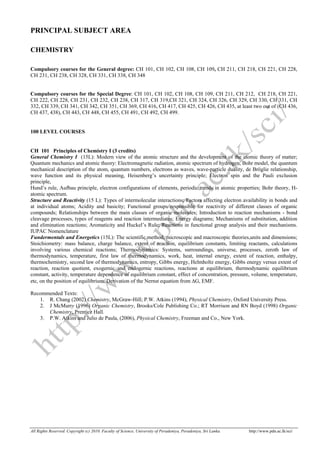
CH-100, first year
- 1. All Rights Reserved. Copyright (c) 2010. Faculty of Science, University of Peradeniya, Peradeniya, Sri Lanka. http://www.pdn.ac.lk/sci/ PRINCIPAL SUBJECT AREA CHEMISTRY Compulsory courses for the General degree: CH 101, CH 102, CH 108, CH 109, CH 211, CH 218, CH 221, CH 228, CH 231, CH 238, CH 328, CH 331, CH 338, CH 348 Compulsory courses for the Special Degree: CH 101, CH 102, CH 108, CH 109, CH 211, CH 212, CH 218, CH 221, CH 222, CH 228, CH 231, CH 232, CH 238, CH 317, CH 319,CH 321, CH 324, CH 326, CH 329, CH 330, CH 331, CH 332, CH 339, CH 341, CH 342, CH 351, CH 369, CH 416, CH 417, CH 425, CH 426, CH 435, at least two out of (CH 436, CH 437, 438), CH 443, CH 448, CH 455, CH 491, CH 492, CH 499. 100 LEVEL COURSES CH 101 Principles of Chemistry I (3 credits) General Chemistry I (15L): Modern view of the atomic structure and the development of the atomic theory of matter; Quantum mechanics and atomic theory: Electromagnetic radiation, atomic spectrum of hydrogen, Bohr model, the quantum mechanical description of the atom, quantum numbers, electrons as waves, wave-particle duality, de Bröglie relationship, wave function and its physical meaning, Heisenberg’s uncertainty principle; Electron spin and the Pauli exclusion principle, Hund’s rule, Aufbau principle, electron configurations of elements, periodic trends in atomic properties; Bohr theory, H- atomic spectrum. Structure and Reactivity (15 L): Types of intermolecular interactions; Factors affecting electron availability in bonds and at individual atoms; Acidity and basicity; Functional groups responsible for reactivity of different classes of organic compounds; Relationships between the main classes of organic molecules; Introduction to reaction mechanisms - bond cleavage processes, types of reagents and reaction intermediates; Energy diagrams; Mechanisms of substitution, addition and elimination reactions; Aromaticity and Huckel’s Rule; Reactions in functional group analysis and their mechanisms. IUPAC Nomenclature Fundermentals and Energetics (15L): The scientific method, microscopic and macroscopic theories,units and dimensions; Stoichiometry: mass balance, charge balance, extent of reaction, equilibrium constants, limiting reactants, calculations involving various chemical reactions; Thermodynamics: Systems, surroundings, universe, processes, zeroth law of thermodynamics, temperature, first law of thermodynamics, work, heat, internal energy, extent of reaction, enthalpy, thermochemistry, second law of thermodynamics, entropy, Gibbs energy, Helmholtz energy, Gibbs energy versus extent of reaction, reaction quotient, exogernic and endogernic reactions, reactions at equilibrium, thermodynamic equilibrium constant, activity, temperature dependence of equilibrium constant, effect of concentration, pressure, volume, temperature, etc, on the position of equilibrium. Derivation of the Nernst equation from ΔG, EMF. Recommended Texts: 1. R. Chang (2002) Chemistry, McGraw-Hill; P.W. Atkins (1994), Physical Chemistry, Oxford University Press. 2. J McMurry (1996) Organic Chemistry, Brooks/Cole Publishing Co.; RT Morrison and RN Boyd (1998) Organic Chemistry, Prentice Hall. 3. P.W. Atkins and Julio de Paula, (2006), Physical Chemistry, Freeman and Co., New York.
- 2. All Rights Reserved. Copyright (c) 2010. Faculty of Science, University of Peradeniya, Peradeniya, Sri Lanka. http://www.pdn.ac.lk/sci/ CH 102 Principles of Chemistry II (3 credits) (Prerequisite: CH 101) General Chemistry II (15 L): Molecular structure: Review of Lewis structures, octet rule and VSEPR model; Bonding: Types of chemical bonds, covalent bonds, electronegativity, polarity and dipole moment, ionic bond, ionic lattices, partial ionic character of covalent bond, non-valence cohesive forces; Hybridization of atomic orbitals, molecular orbital theory, magnetic properties. Three- center bond, resonance, bonding in homonuclear and heteronuclear diatomic models; applications of size and energy factors in chemistry; Basic concepts in chemical analysis: titrations, buffers, indicators, solubility equilibria and applications. Kinetic Molecular Theory (KMT) and Chemical Kinetics (15L): KMT as a model for microscopic theories, experimental evidence, properties of gases, the perfect gas, state of gases, individual gas laws, combined gas laws, kinetic model for gases, imperfect gases; Molecular collisions; The importance of chemical kinetics: Rates, mechanisms, relationship between rate of reaction and rate of change of concentration of components; Rate law, rate constant and order, overall order of a reaction, initial rate method, integrated rate laws, isolation method, half-life of a reaction and a relationship to rate constant, molecularity of a reaction, the Arrhenius relationship between temperature and rate of a reaction, activation energy and pre-exponential factor, Steady-state approximation, pre-equilibrium. Stereochemistry (15 L): Configurational isomers, E,Z-nomenclature, symmetry, chirality; R,S-nomenclature, meso compounds, diastereomers. conformations in acyclic and cyclic compounds, cis-trans and optical isomerism in cyclic compounds; biphenyls, allenes, Stereochemical course of organic reactions (SN1, SN2, E1,E2) and effect of solvent on substitution reactions. Recommended Texts: 1. R. Chang (1996) Chemistry, McGraw-Hill; P.W. Atkins (1999), Physical Chemistry, Oxford University Press. 2. J McMurry (1996) Organic Chemistry, Brooks/Cole Publishing Co; RT Morrison and RN Boyd (1998) Organic Chemistry, Prentice Hall. 3. P.W. Atkins and Julio de Paula, (2006), Physical Chemistry, Freeman and Co., New York. CH 108 Elementary Chemistry Laboratory I (1 credit) Qualitative analysis; Analysis of inorganic anions, cations and their mixtures, Quantitative Inorganic analysis by volumetric titrations. Recommended Texts: 1. A.I. Vogel, A.I. Vogel, Qualitative Inorganic Analysis (2004), Longman Scientific 2. A.I. Vogel, Quantitative Inorganic Analysis (2004), Longman Scientific CH 109 Elementary Chemistry Laboratory II (1 credit) (Prerequisite: CH108) Organic functional group analysis, Apparatus and measurements. Introduction to chemometrics.